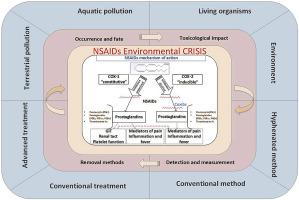Environmental Pollution ( IF 7.6 ) Pub Date : 2020-08-21 , DOI: 10.1016/j.envpol.2020.115370 Parnian Izadi , Parin Izadi , Rana Salem , Sifat Azad Papry , Sara Magdouli , Rama Pulicharla , Satinder Kaur Brar

|
Non-steroidal anti-inflammatory drugs (NSAIDs) are among the most well-known pharmaceuticals with a broad scope of properties that are widely used in human and veterinary medicine. Because of their extensive utilization, NSAIDs are commonly identified in the environment as trace emerging contaminants. Regardless of vast experience with these drugs, NSAIDs are full of contradictions that trigger major concerns for environmental researchers. A limited understanding on NSAID’s occurrence, distribution and eco-toxicological effects have led to an escalated dilemma in the last decade. Thus, a broad-spectrum study covering all aspects of occurrence, detection and removal is required to meet the fundamental levels of knowledge on the effects of NSAIDs in all exposed environmental aspects. Therefore, this paper focuses on classifying the sources and entry points of residual NSAIDs. Further, detecting and regulating their concentrations in both input streams and receiving environments, along with the removal processes of this specific class of emerging compounds, in the direction of developing a management policy is comprehensively reviewed.
中文翻译:

环境中的非甾体类抗炎药:我们到哪里去了?
非甾体类抗炎药(NSAIDs)是最著名的药物之一,具有广泛的特性,已广泛用于人类和兽医学。由于它们的广泛使用,NSAID在环境中通常被识别为微量新兴污染物。不管使用这些药物的丰富经验如何,NSAID充满了矛盾,引发了环境研究人员的重大关切。在过去十年中,对NSAID的发生,分布和生态毒理学影响的了解有限,导致两难升级。因此,需要进行广泛的研究,涵盖发生,检测和清除的所有方面,以使人们对非甾体抗炎药在所有暴露的环境方面的影响具有基本的认识。因此,本文着重于对残留NSAID的来源和切入点进行分类。此外,在制定管理政策的方向上,全面审查了在输入流和接收环境中检测和调节它们的浓度,以及这类新兴化合物的去除过程。











































 京公网安备 11010802027423号
京公网安备 11010802027423号